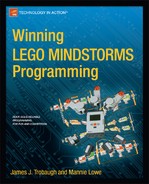Book Description
Winning LEGO MINDSTORMS Programming is your ticket to successfully programming for fun and competition with LEGO MINDSTORMS and the NXT-G programming language commonly used in FIRST LEGO League events. The book is a companion title to author James Trobaugh's acclaimed book on physical robot design, Winning Design!. This new book focuses squarely on the programming side of working with MINDSTORMS. Together the two books put you on a rock-solid foundation for creating with LEGO MINDSTORMS, whether for fun at home or in competition with a team.
Winning LEGO MINDSTORMS Programming sets the stage by emphasizing the importance of up front planning, and thinking about the challenge to be met. Learn to evaluate possible solutions by sanity-testing their logic before you put the effort into actually writing the code. Then choose your best option and write the code applying the techniques in this book. Take advantage of language features such as MyBlocks to enhance reliability and create easy-to-debug code. Manage your code as you change and improve it so that you can trace what you've done and fall back if needed. Avoid common programming pitfalls. Work powerfully with teammates to conquer competition challenges of all types.
Provides solid techniques similar to those used by professional programmers, and optimized for the LEGO MINDSTORMS platform.
Addresses key tasks important to competition such as line detection, line following, squaring of corners, motor stall detection, and more.
Compliments Winning Design! by tackling the programming side of competition.
What you'll learn
Write programs to give your team an edge in competition.
Avoid common programming pitfalls that can cost points.
Write well-planned code easily adapted as you refine your approach to a challenge.
Collaborate with teammates in presenting a clear understanding of your coding solution to competition judges.
Improve your ability to wield each of the MINDSTORM NXT sensors.
Explore tips & tricks that can be used in robot competitions, and for fun.
Plan ahead for debugging and troubleshooting.
Who this book is for
Winning LEGO MINDSTORMS Programming is aimed at those wanting to improve their ability to create and deploy LEGO MINDSTORMS robots that are predictable and reliable at navigating competition challenges, and for fun at home.
Table of Contents
- Title
- Dedication
- Contents at a Glance
- Contents
- About the Authors
- About the Technical Reviewer
- Acknowledgments
- Introduction
- Chapter 1: Meeting the NXT-G Software
- Chapter 2: Software Design Process
- Chapter 3: Working with My Blocks
- Chapter 4: When Things Go Wrong
- Chapter 5: Moving Data
- Chapter 6: Making Smart Decisions
- Chapter 7: Motors and Motion
- Chapter 8: Light Detection
- Chapter 9: Touching and Bumping
- Chapter 10: Seeing with Ultrasonics
- Chapter 11: Programming Like a Pro
- Chapter 12: Code Management
- Chapter 13: Programming Pitfalls
- Chapter 14: Tips and Tricks
- Index
